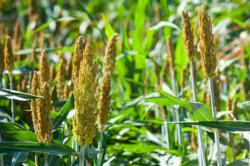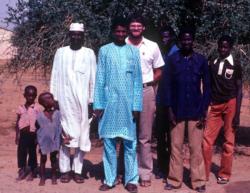Jeff Dahlberg
Gluten-free sorghum a potential California crop

Increasing interest in gluten-free diets for humans may open new doors for the crop. Sorghum grain can be milled like wheat to produce a white flour for flat bread, cookies, pancakes and waffles. Whole sorghum grain may be added to soups, makes a dish similar to couscous, and can be popped like popcorn for snacking. The stems of sweet sorghum can be pressed, like sugarcane, to produce sorghum molasses or syrup.
UC expert believes sorghum can ease water concerns
As a Peace Corps volunteer in Niger, Africa, in the early 1980s, Jeff Dahlberg was intrigued by sorghum, a staple food being cultivated by the country’s vast population of poor subsistence farmers.
“I was impressed with the fact that sorghum was so drought tolerant,” Dahlberg said. “They used no irrigation at all.”
More than 30 years later, Dahlberg, the director of the UC Kearney Agricultural Research and Extension Center in Parlier, is still impressed with sorghum and believes it has potential to be a significant crop in California, where water is a serious concern.
Dahlberg earned a bachelor's degree in biology at Occidental College before travling to Niger. In the central African country, Dahlberg served as an agricultural extension agent for the Peace Corps, where he worked iwth local farmers to assess the impact of rodents on traditional storage for grains. He and his colleagues learned earned was that the traditional storage methods were effective. Dahlberg’s primary method of outreach in Niger was demonstration plots. While living in West Africa, he traveled extensively, and experienced first-hand the role of millet and sorghum in feeding local populations.

Studying sorghum varieties in California
The California sorghum research now underway at Kearney and the UC West Side Research and Extension Center is focused on hybrid forage and grain sorghum varieties. The results will also be applicable to varieties for human food and biofuel.
“We’re trying to understand whether or not the hybrids developed for the U.S. Sorghum Belt – Texas, Oklahoma, western Nebraska and South Dakota – are adapted to California conditions,” Dahlberg said. “So far, they are doing very well.”
The forage research will determine how to manage sorghum to maximize yield and reduce water and nitrogen use. Early results show that farmers can save a significant amount of water growing sorghum for dairy silage when compared with corn.
“We use less than 20 inches of irrigation water on our sorghum plots and getting 22 to 25 wet tons of material off a single crop. A corn crop will need 36 inches of water or more,” Dahlberg said.
The crop’s fertilizer needs are also quite low. In fact, too much fertilizer can cause the sorghum stalks to fall down, or lodge, which hinders harvest.
"When California farmers think about growing sorghum for gluten-free food, biofuel or animal feed, they will be able to access information generated by local research to help them make the decision," Dahlberg said.


